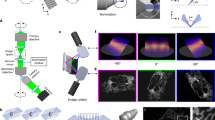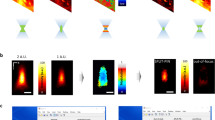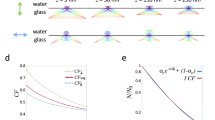Abstract
A key requirement for performing three-dimensional (3D) imaging using optical microscopes is that they be capable of optical sectioning by distinguishing in-focus signal from out-of-focus background. Common techniques for fluorescence optical sectioning are confocal laser scanning microscopy and two-photon microscopy. But there is increasing interest in alternative optical sectioning techniques, particularly for applications involving high speeds, large fields of view or long-term imaging. In this Review, I examine two such techniques, based on planar illumination or structured illumination. The goal is to describe the advantages and disadvantages of these techniques.
This is a preview of subscription content, access via your institution
Access options
Subscribe to this journal
Receive 12 print issues and online access
$259.00 per year
only $21.58 per issue
Buy this article
- Purchase on Springer Link
- Instant access to full article PDF
Prices may be subject to local taxes which are calculated during checkout







Similar content being viewed by others
References
Denk, W., Strickler, J. & Webb, W. Two-photon laser scanning fluorescence microscopy. Science 248, 73–76 (1990).
Pawley, J., ed. Handbook of Biological Confocal Microscopy, 3rd edn. (Springer, 2006).
Conchello, J.-A. & Lichtman, J.W. Optical sectioning microscopy. Nat. Methods 2, 920–931 (2005).
Helmchen, F. & Denk, W. Deep tissue two-photon microscopy. Nat. Methods 2, 932–940 (2005).
Svoboda, K. & Yasuda, R. Principles of two-photon excitation microscopy and its applications to neuroscience. Neuron 50, 823–839 (2006).
Siedentopf, H. & Zsigmondy, R. Uber sichtbarmachung und groessenbestimmung ultramikroskopischer teilchen, mit besonder anwendung auf goldrubinglaesern. Ann. Phys. 10, 1–39 (1903).
Voie, A.H., Burns, D.H. & Spelman, F.A. Orthogonal-plane fluorescence optical sectioning: three dimensional imaging of macroscopic biological specimens. J. Microsc. 170, 229–236 (1993).
Fuchs, E., Jaffe, J., Long, R. & Azam, F. Thin laser light sheet microscope for microbial oceanography. Opt. Express 10, 145–154 (2002).
Huisken, J., Swoger, J., Del Bene, F., Wittbrodt, J. & Stelzer, E.H.K. Optical sectioning deep inside live embryos by selective plane illumination microscopy. Science 305, 1007–1009 (2004). The first paper to highlight the advantages of planar illumination for developmental imaging, essentially launching the renaissance of PIM.
Dodt, H.-U. et al. Ultramicroscopy: three-dimensional visualization of neuronal networks in the whole mouse brain. Nat. Methods 4, 331–336 (2007). Optical clearing and PIM are combined for the first time, demonstrating high resolution, anatomical imaging over wide fields of view.
Buytaert, J.A.N. & Dirckx, J.J.J. Design and quantitative resolution measurements of an optical virtual sectioning three-dimensional imaging technique for biomedical specimens, featuring two-micrometer slicing resolution. J. Biomed. Opt. 12, 014039 (2007).
Keller, P.J., Schmidt, A.D., Wittbrodt, J. & Stelzer, E.H.K. Reconstruction of zebrafish early embryonic development by scanned light sheet microscopy. Science 322, 1065–1069 (2008).
Holekamp, T.F., Turaga, D. & Holy, T.E. Fast three-dimensional fluorescence imaging of activity in neural populations by objective-coupled planar illumination microscopy. Neuron 57, 661–672 (2008).
Tokunaga, M., Imamoto, N. & Sakata-Sogawa, K. Highly inclined thin illumination enables clear single-molecule imaging in cells. Nat. Methods 5, 159–162 (2008).
Santi, P.A. et al. Thin-sheet laser imaging microscopy for optical sectioning of thick tissues. Biotechniques 46, 287–294 (2009).
Palero, J., Santos, S.I.C.O., Artigas, D. & Loza-Alvarez, P. A simple scanless two-photon fluorescence microscope using selective plane illumination. Opt. Express 18, 8491–8498 (2010).
Truong, T.V., Supatto, W., Koos, D.S., Choi, J.M. & Fraser, S.E. Deep and fast live imaging with two-photon scanned light-sheet microscopy. Nat. Methods 8, 757–760 (2011). Advantages of 2P-PIM compared to 1P-PIM for imaging thick samples are highlighted.
Planchon, T.A. et al. Rapid three-dimensional isotropic imaging of living cells using Bessel beam plane illumination. Nat. Methods 8, 417–423 (2011). The combination of PIM with high-numerical-aperture optics provides ultrafast volumetric imaging with isotropic sub-micrometer resolution.
Hoebe, R.A. et al. Controlled light-exposure microscopy reduces photobleaching and phototoxicity in fluorescence live-cell imaging. Nat. Biotechnol. 25, 249–253 (2007).
Chu, K.K., Lim, D. & Mertz, J. Enhanced weak-signal sensitivity in two-photon microscopy by adaptive illumination. Opt. Lett. 32, 2846–2848 (2007).
Chu, K.K., Lim, D. & Mertz, J. Practical implementation of log-scale active illumination microscopy. Biomed. Opt. Express 1, 236–245 (2010).
Mertz, J.C. Introduction to Optical Microscopy. (Roberts and Company Publishers, 2009).
Durnin, J., Miceli, J.J. & Eberly, J.H. Diffraction-free beams. Phys. Rev. Lett. 58, 1499–1501 (1987).
Fahrbach, F.O., Simon, P. & Rohrbach, A. Microscopy with self-reconstructing beams. Nat. Photonics 4, 780–785 (2010).
Keller, P.J. & Stelzer, E.H.K. Quantitative in vivo imaging of entire embryos with digital scanned laser light sheet fluorescence microscopy. Curr. Opin. Neurobiol. 18, 624–632 (2008).
Reynaud, E.G., Kržič, U., Greger, K. & Stelzer, E.H.K. Light sheet-based fluorescence microscopy: more dimensions, more photons, and less photodamage. HFSP J. 2, 266–275 (2008).
Hopt, A. & Neher, E. Highly nonlinear photodamage in two-photon fluorescence microscopy. Biophys. J. 80, 2029–2036 (2001).
Dunsby, C. Optically sectioned imaging by oblique plane microscopy. Opt. Express 16, 20306–20316 (2008).
Turaga, D. & Holy, T.E. Miniaturization and defocus correction for objective-coupled planar illumination microscopy. Opt. Lett. 33, 2302–2304 (2008).
Engelbrecht, C.J., Voigt, F. & Helmchen, F. Miniaturized selective plane illumination microscopy for high-contrast in vivo fluorescence imaging. Opt. Lett. 35, 1413–1415 (2010).
Olivier, N. et al. Cell lineage reconstruction of early zebrafish embryos using label-free nonlinear microscopy. Science 329, 967–971 (2010).
Huisken, J. & Stainier, D.Y.R. Even fluorescence excitation by multidirectional selective plane illumination microscopy (mSPIM). Opt. Lett. 32, 2608–2610 (2007).
Huisken, J. & Stainier, D.Y.R. Even fluorescence excitation by multidirectional selective plane illumination microscopy (mSPIM). Opt. Lett. 32, 2608–2610 (2007).
Becker, K., Jährling, N., Kramer, E.R., Schnorrer, F. & Dodt, H.-U. Ultramicroscopy: 3D reconstruction of large microscopical specimens. J. Biophotonics 42, 36–42 (2008).
Oron, D., Tal, E. & Silberberg, Y. Scanningless depth resolved microscopy. Opt. Express 13, 1468–1476 (2005).
Zhu, G., Howe, J.V., Durst, M., Zipfel, W. & Xu, C. Simultaneous spatial and temporal focusing of femtosecond pulses. Opt. Express 13, 2153–2159 (2005).
Heintzmann, R. & Benedetti, P.A. High-resolution image reconstruction in fluorescence microscopy with patterned excitation. Appl. Opt. 45, 5037–5045 (2006).
Heintzmann, R. Structured illumination methods. in Handbook of Biological Confocal Microscopy, 3rd edn. (Pawley, J., ed.) 265–279 (Springer, 2006).
Petran, M., Hadravsky, M., Egger, M.D. & Galambos, R. Tandem-scanning reflected-light microscope. J. Opt. Soc. Am. 58, 661–664 (1968).
Sheppard, C.J.R. & Mao, X.Q. Confocal microscopes with slit apertures. J. Mod. Opt. 35, 1169–1185 (1988).
Heintzmann, R. et al. Resolution enhancement by subtraction of confocal signals taken at different pinhole sizes. Micron 34, 293–300 (2003).
Wilson, T., Juškaitis, R., Neil, M. & Kozubek, M. Confocal microscopy by aperture correlation. Opt. Lett. 21, 1879–1881 (1996). A key precursor to the development of DSD microscopy.
Neil, M., Wilson, T. & Juskaitis, R. A light efficient optically sectioning microscope. J. Microsc. 189, 114–117 (1998).
Verveer, P., Hanley, Q., Verbeek, P., Van Vliet, L. & Jovin, W. Theory of confocal fluorescence imaging in the programmable array microscope (PAM). J. Microsc. 189, 192–198 (1998). A key precursor to the development of DSD microscopy.
Hanley, Q., Verveer, P., Gemkow, M., Arndt-Jovin, D. & Jovin, T. An optical sectioning programmable array microscope implemented with a digital micromirror device. J. Microsc. 196, 317–331 (1999).
Heintzmann, R., Hanley, Q.S., Arndt-Jovin, D. & Jovin, T.M. A dual path programmable array microscope (PAM): simultaneous acquisition of conjugate and non-conjugate images. J. Microsc. 204, 119–135 (2001).
Wilson, T., Neil, M.A.A. & Juskaitis, R. Confocal microscopy apparatus and method. US patent 6,687052 B1 (2004).
Neil, M., Juskaitis, R. & Wilson, T. Method of obtaining optical sectioning by using structured light in a conventional microscope. Opt. Lett. 22, 1905–1907 (1997). The first demonstration of how structured illumination can provide optical sectioning, initiating the technique of SIM in general.
Gustafsson, M. Surpassing the lateral resolution limit by a factor of two using structured illumination microscopy. J. Microsc. 198, 82–87 (2000).
Gustafsson, M.G.L. et al. Three-dimensional resolution doubling in wide-field fluorescence microscopy by structured illumination. Biophys. J. 94, 4957–4970 (2008).
Shroff, S.A., Fienup, J.R. & Williams, D.R. Phase-shift estimation in sinusoidally illuminated images for lateral superresolution. J. Opt. Soc. Am. A Opt. Image Sci. Vis. 26, 413–424 (2009).
Kner, P., Chhun, B.B., Griffis, E.R., Winoto, L. & Gustafsson, M.G.L. Super-resolution video microscopy of live cells by structured illumination. Nat. Methods 6, 339–342 (2009).
Lim, D., Chu, K.K. & Mertz, J. Wide-field fluorescence sectioning with hybrid speckle and uniform-illumination microscopy. Opt. Lett. 33, 1819–1821 (2008).
Lim, D., Ford, T.N., Chu, K.K. & Mertz, J. Optically sectioned in vivo imaging with speckle illumination HiLo microscopy. J. Biomed. Opt. 16, 016014 (2011). Advantages of HiLo microscopy for fast, in vivo imaging over wide fields of view are highlighted.
Karadaglic, D., Juskaitis, R. & Wilson, T. Confocal endoscopy via structured illumination. Scanning 24, 301–304 (2002).
Bozinovic, N., Ventalon, C., Ford, T. & Mertz, J. Fluorescence endomicroscopy with structured illumination. Opt. Express 16, 4603–4610 (2008).
Santos, S. et al. Optically sectioned fluorescence endomicroscopy with imaging through a flexible fiber bundle. J. Biomed. Opt. 14, 030502 (2009).
Breuninger, T., Greger, K. & Stelzer, E.H.K. Lateral modulation boosts image quality in single plane illumination fluorescence microscopy. Opt. Lett. 32, 1938–1940 (2007).
Kalchmair, S., Jährling, N., Becker, K. & Dodt, H.-U. Image contrast enhancement in confocal ultramicroscopy. Opt. Lett. 35, 79–81 (2010).
Keller, P.J. et al. Fast, high-contrast imaging of animal development with scanned light sheet-based structured-illumination microscopy. Nat. Methods 7, 637–642 (2010).
Mertz, J. & Kim, J. Scanning light-sheet microscopy in the whole mouse brain with HiLo background rejection. J. Biomed. Opt. 15, 016027 (2010).
Acknowledgements
I acknowledge the help of W. Supatto, K. Chu, D. Lim and T. Ford for critically reading this manuscript.
Author information
Authors and Affiliations
Corresponding author
Ethics declarations
Competing interests
The author declares no competing financial interests.
Rights and permissions
About this article
Cite this article
Mertz, J. Optical sectioning microscopy with planar or structured illumination. Nat Methods 8, 811–819 (2011). https://doi.org/10.1038/nmeth.1709
Published:
Issue Date:
DOI: https://doi.org/10.1038/nmeth.1709
This article is cited by
-
Parallel interrogation of the chalcogenide-based micro-ring sensor array for photoacoustic tomography
Nature Communications (2023)
-
DEEP-squared: deep learning powered De-scattering with Excitation Patterning
Light: Science & Applications (2023)
-
Whole-brain Optical Imaging: A Powerful Tool for Precise Brain Mapping at the Mesoscopic Level
Neuroscience Bulletin (2023)
-
Real-time holographic lensless micro-endoscopy through flexible fibers via fiber bundle distal holography
Nature Communications (2022)
-
An adaptive microscope for the imaging of biological surfaces
Light: Science & Applications (2021)



